Published by Robert Hale in 1975, 205 pages. It's currently available from Amazon UK for the princely sum of 1p!
Most unusually for an Edward II novel, The She-Wolf opens in 1325, shortly before Edward sends Isabella to France to negotiate with her brother Charles IV over the Gascon situation. It closes just after Edward III's successful coup against his mother and Roger Mortimer in late 1330.
Pamela Bennetts has an excellent understanding of the politics and general comings and goings of Edward II's reign, although sometimes she uses infodumps in the narrative to get the point across. Also, the late opening of the novel requires a lot of flashbacks in the first chapter to see Piers Gaveston, and the fact that falling in love with men is a pattern of Edward's behaviour. However, these are minor criticisms; the dialogue and characterisation are uniformly excellent.
I've never read another Edward II novel where Queen Isabella is so unsympathetic - the title is highly appropriate! Much of The She-Wolf is seen through the eyes of Isabella's attendants, who slowly come to realise that the sweet, suffering woman they adore is in fact - not to put too fine a point on it - a complete bitch, calculating, manipulative and so full of anger and hatred that she's almost abnormal. Even Roger Mortimer, who's also described as almost insane with ambition and bitterness, is frightened at what he unleashes. Isabella watches the execution of the younger Despenser and regrets that he doesn't last longer and suffer more. She is completely indifferent to her husband's murder, and the execution of her brother-in-law Kent. And yet, the reader can't help but feel sorry for her, at least in the earlier part of the novel. She genuinely yearned for Edward when they first married, and felt unclean at the thought of his relationship with Gaveston. Her frustrated love is warped and twisted until she feels nothing but hatred and contempt for her husband, and her relationship with Mortimer has nothing sweet or tender about it - it's based on lust and control.
Mortimer and Isabella are masters of propaganda here - even Isabella's reunion with her younger children in Bristol in October 1326 is stage-managed in front of a crowd to increase their sympathy for a woman deprived of her children by her heartless husband, and Mortimer only pretends to care that his wife and own children have been imprisoned, because it gives him a stronger reason to take revenge on the king and Despenser. Even Mortimer doesn't trust Isabella completely.
Edward II himself is reasonably sympathetic. At the start of the novel, he and Isabella utterly detest one another - they speak honeyed words to each other in public, while wanting to spit at and slap each other. It's a lovely portrayal of a marriage that's gone as wrong as a marriage possibly could. Although Isabella chooses to believe otherwise, and spreads vicious rumours about them, he and Hugh Despenser are not lovers here. Edward loves Despenser, but only because Despenser supports him and takes on the burden of ruling, which Edward doesn't want.
Edward III, after his father's murder - by the usual method - realises that the only way he will survive and overcome Mortimer is to bide his time, and copy his mother in hiding his true feelings and his true nature, and pretending to be meek and biddable.
In conclusion, this short novel is well worth a read, with excellent characterisation and genuine suspense near the end, as the reader wonders whether Edward III will be successful in his coup against Isabella and Mortimer - even while knowing that, historically, he was. But it's definitely not a novel for anyone who believes the recently popular 'Isabella has been unfairly maligned by history' theory!
Welcome to the site which examines the events, issues and personalities of Edward II's reign, 1307-1327.
29 October, 2006
21 October, 2006
Novels, names and Nottingham (and a tomb)
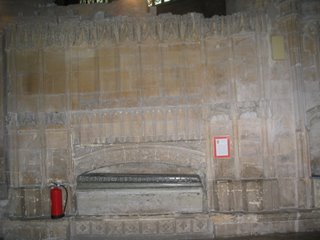
This is the tomb of Hugh le Despenser the younger, buried in Tewkesbury Abbey in late 1330 or early 1331, after the five parts of his body had been on public display around England for four years. The tomb was much mutilated in the sixteenth century, and used to contain forty statues. The coffin actually belongs to Abbot John Cotes, who died in 1347 - and who was probably the man who presided over Hugh's funeral. For some reason, his coffin was placed in the tomb in the seventeenth century. Despenser's remains are presumably underneath.
Barbara Green of the Yorkshire Robin Hood Society has left a long and fascinating comment on an old post, here. Many thanks for that, Barbara! She points out that, contrary to popular belief, the real Robin Hood most likely did not live in Richard I's reign, but in Edward II's. This has inspired me to follow up her references and read more about this. (Anyone watching the BBC's Robin Hood, by the way? I caught the first one during my holiday. One episode was more than enough, I think.)
Remember the romance novel Infamous, that I reviewed a while back? The sequel Notorious is due out next May, starring Jory de Warenne's daughter Brianna. According to this message board, the hero is Roger Mortimer's son....Wolf.
Words fail me.
A novel far superior to this one, I'm sure, is currently being written - one that takes place in 1330 and has the hero playing a role in Edward III's coup against Isabella and Roger Mortimer (yes, the one who fathered a son named Wolf. Allegedly.) I don't know the identity of the author, but you can see an extract of her work in progress here. She was also kind enough to leave some comments on the post below this one. Isabella, according to the author, is very much the 'She-Wolf' here - in my view, a welcome antidote to the fawning dissertations, biographies and novels featuring Isabella that are currently fashionable.
And finally, on the subject of Edward III's 1330 coup, Susan Higginbotham has written an excellent post on the subject. The 676th anniversary fell a couple of days ago (assuming my maths is correct; it's been a long week). Susan draws attention to Isabella and Mortimer's foolish behaviour during their regency. They'd invaded England supposedly to liberate the people from the tyranny of the Despenser regime, but proved themselves to be even greedier and less able to command the loyalty of their followers - something all too often conveniently ignored in recent works on Isabella.
15 October, 2006
Photos
A detail of Hugh the younger Despenser's tomb at Tewkesbury Abbey, showing some of the statues that were mutilated in the sixteenth century - his tomb was magnificent before that (for some reason Blogger won't let me upload the photo of it, so I'll save it for another post):
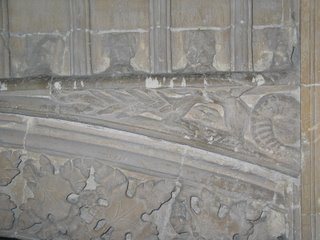
The Three Kings pub in Hanley Castle, Worcestershire:
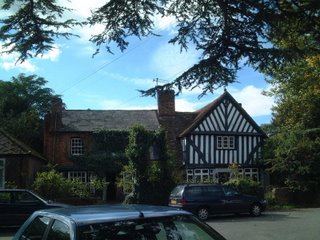
The church at Hanley Castle:

The 'Kneeling Knight' of Tewkesbury - Edward, Lord Despenser (1336-1375), grandson of Hugh the Younger and grandfather of Isabelle, below. His son Thomas was created earl of Gloucester in 1397 and beheaded in 1400, trying to put Richard II back on the throne. Edward was described by the chronicler Jean Froissart as the most handsome, the most courteous and the most honourable knight in England' (qualities he probably didn't inherit from his notorious grandfather ;)
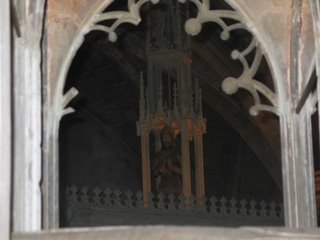
The Despenser/Beauchamp chantry at Tewkesbury - paid for by Isabelle Despenser (1400-1439), great-great-granddaughter of Hugh the Younger and grandmother of Richard III's queen, Anne Neville. Isabelle had two husbands, both called Richard Beauchamp. ;) I love this photo because you can still see the colours of the chantry.
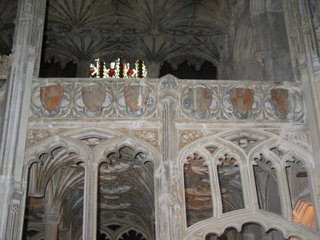
And for no other reason except that she's terribly cute, here's my mum's dog, Tara. ;)


The Three Kings pub in Hanley Castle, Worcestershire:

The church at Hanley Castle:

The 'Kneeling Knight' of Tewkesbury - Edward, Lord Despenser (1336-1375), grandson of Hugh the Younger and grandfather of Isabelle, below. His son Thomas was created earl of Gloucester in 1397 and beheaded in 1400, trying to put Richard II back on the throne. Edward was described by the chronicler Jean Froissart as the most handsome, the most courteous and the most honourable knight in England' (qualities he probably didn't inherit from his notorious grandfather ;)

The Despenser/Beauchamp chantry at Tewkesbury - paid for by Isabelle Despenser (1400-1439), great-great-granddaughter of Hugh the Younger and grandmother of Richard III's queen, Anne Neville. Isabelle had two husbands, both called Richard Beauchamp. ;) I love this photo because you can still see the colours of the chantry.

And for no other reason except that she's terribly cute, here's my mum's dog, Tara. ;)

More photos
The site of Hanley Castle, Worcestershire - built by King John in the early 1200s, passed to the de Clares and then to the Despensers, derelict by the sixteenth century:

Windows in the choir of Tewkesbury Abbey, paid for by Eleanor de Clare:
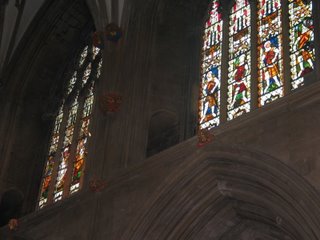
Deerhurst church (founded before 804):
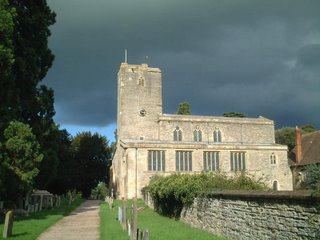
Odda's Chapel (consecrated 1056):
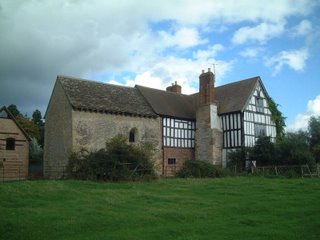
Hailes Abbey (founded 1246):
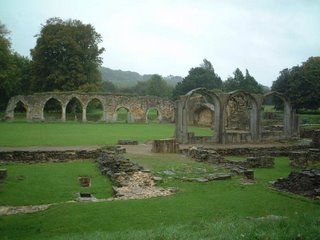
Sudeley Castle, from the back seat of the car:
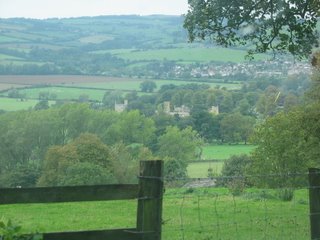
Berkeley Castle:
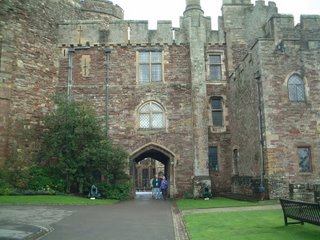
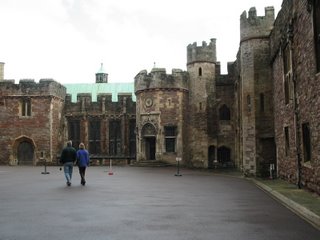
EDIT: Blogger, or my PC, is having a snit - I'll post the remaining photos later, or tomorrow.

Windows in the choir of Tewkesbury Abbey, paid for by Eleanor de Clare:

Deerhurst church (founded before 804):

Odda's Chapel (consecrated 1056):

Hailes Abbey (founded 1246):

Sudeley Castle, from the back seat of the car:

Berkeley Castle:


EDIT: Blogger, or my PC, is having a snit - I'll post the remaining photos later, or tomorrow.
13 October, 2006
My Edward II Pilgrimage
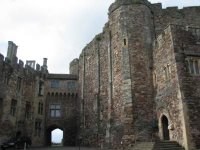
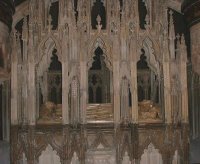
I had a great time in Gloucestershire, visiting sites associated with Edward II. The thing I most wanted to see was Edward II's tomb, in Gloucester Cathedral - a magnificent canopied shrine described by the Cathedral as 'one of the great monuments of England'. The shrine is currently covered in scaffolding, as it's being restored, at a cost of £70,000, apparently. The Cathedral is planning a 'series of events to commemorate Edward II' in 2007 and 2008.
I found it really moving to be so close to Edward - I stood there for ages, until one of the men working on the tomb started giving me funny looks. The day before, we'd visited Berkeley Castle, where Edward was imprisoned in 1327 (and freed by some of his supporters - see the comments on this post). I'm afraid to say I found Berkeley rather disappointing, at least from an Edward point of view. Much of the castle is closed to visitors, and the guided tour barely mentions Edward and focuses instead on the later Berkeleys. You can see the cell where Edward was held, but not enter it - you can only peer through a rather narrow window. I was hoping to get some idea of how the Dunheveds might have entered the castle in 1327 and freed Edward, but unfortunately I couldn't picture it at all. Still, Berkeley is well worth a visit (it's closed till next April, however) for anyone interested in later periods of history. I did enjoy seeing the Great Hall, which was rebuilt by Thomas Berkeley, Edward's jailor, around 1340.
In the photo (left, above) Edward's cell is above the doorway on the right.
We also visited Tewkesbury Abbey, a superb building consecrated in 1121, bigger than fourteen English cathedrals, which was saved during the Dissolution when the townspeople bought it for £453. The Abbey is practically the mausoleum of the Despenser family - the notorious Hugh the Younger was buried here in late 1330, in five pieces, after Edward III finally gave permission for his rotting remains to be removed from London Bridge, York, Carlisle, Bristol and Dover four years after his execution. His wife Eleanor de Clare is here (burial place unfortunately unknown) as are numerous descendants of theirs.
Another site associated with the Despensers is Hanley Castle, in Worcestershire. Sadly there's absolutely nothing left of the castle itself - except the flat hill where it once existed - but Hanley Castle, the village, is very pretty with a lovely old church and a school founded in 1326. Edward II and Queen Isabella were guests of Hugh Despenser here in January 1324, and Eleanor de Clare was abducted from Hanley by her second husband, William la Zouche, in early 1329.
We also took the opportunity to visit other historical sites in Gloucestershire and Worcestershire. Evesham is the site of a battle of 1265, where Edward II's father defeated Simon de Montfort, earl of Leicester - his uncle by marriage. Roger Mortimer - grandfather of Edward II's Roger Mortimer - sent de Montfort's head to his wife as a present! Worcester Cathedral contains the tomb of Edward II's great-grandfather King John (died 1216) as well as the chantry of Prince Arthur, elder brother of Henry VIII. The village of Deerhurst, a mile or so from where we were staying, contains two pre-Conquest buildings, astonishingly enough: Odda's Chapel, of 1056, and the Church of St Mary, which dates back to before 804. We didn't go in, but saw Sudeley Castle, former home of Henry VIII's last wife Katherine Parr, and spent a morning in the driving rain looking around Hailes Abbey - founded in 1246 by Henry III's brother Richard of Cornwall. Hailes was a very important place of pilgrimage in the Middle Ages.
All in all, I had a great holiday in a lovely, really interesting part of England!
Subscribe to:
Posts (Atom)